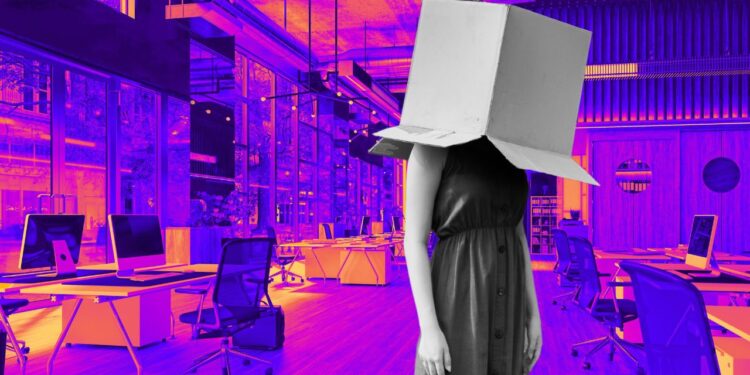- According to the factor-five model of personality, introverts and extroverts differ when it comes to how being around others impacts their energy levels. Introverts are generally drained by the presence of others, whereas extroverts thrive in social environments.
- Most often, offices are designed to cater to the needs of extroverts, at the expense of introverts and their diametric needs.
- Having options in available work modalities can help accommodate the needs of introverts, who work better under more independent, less social conditions.
The idea of returning to the office, or the mandate to do so, has left many people on edge wondering how to succeed in a space where they have little-to-no control over their environment.
Personality types can strongly influence a person’s reaction to having to work from an office for any amount of time. Personality-wise, extroverts and introverts differ with respect to how much they like to be around people. More specifically, the difference between extroverts and introverts is primarily in how being around others impacts their energy levels.
Extroverts get ample energy from others, whereas introverts lose energy around others. Usually, introverts can tolerate one or two other people well for extended periods, but being in groups is like kryptonite to an introvert.
Where extroverts get excited by the prospect of being around others, introverts are exhausted by it. So, the social needs of introverts versus extroverts are opposed — and all people fit somewhere between these extreme ends of this personality scale.
What do introverts and extroverts need in workspaces?
Given the significant variance in needs between introverts and extroverts, and the fact that workspaces are social spaces, managers need to take note of what work styles and environments would best suit their team members.
We know, for instance, that introverts tend to have their needs neglected by employers at the expense of extroverts — to such an extent that psychologists call this cultural phenomenon an “extrovert‘s world.”
Extroverts need big, open office spaces where talking and collaboration are incentivized; an office that is generally loud, motivational, gregarious, and — from a purely sensory perspective — stimulating.
Working near bright lights and many other people, with incentives to grab food with a coworker, and the inclusion of many meetings can all be a part of the perfect arrangement for extroverted workers.
Most of all, extroverts thrive around others, so accommodating a work environment for extroverts is best done by having a place where friendly and outgoing people meet in person daily.
This is how most work environments are set up: in person with an expectation on workers to be outgoing and to put on the face of a people-person. But this environment drains introverted workers, who comprise an estimated 30%-50% of the workforce.
For the most part, introverts need to be alone most of the time, or else it will become difficult for them to regulate their energy levels and emotions. Making someone who flourishes when they’re alone be around other people all day can make them depressed and anxious.
How to organize a workspace for extroverts versus introverts
Accommodating introverts is challenging in an extrovert’s world; humanity cannot suddenly become less extroverted. Most people are extroverts, and most cultures and societies will always primarily appeal to sociability.
This does not mean that introverts need to be left behind, unaccommodated in their needs. On the contrary, nothing needs to change about in-person work environments for introverts to become accommodated.
It’s true: In-person offices can still be rather loud and exciting places for extroverts to work without introverts taking the boot.
First and foremost, this means having options for work modalities, such as remote and hybrid work options.
Remote options give highly introverted workers the chance of near-total independence from others at work. This will make them the most comfortable and productive they can be.
Introverts who are somewhat less introverted and desire socializing from time to time should be given a hybrid option, with in-person office space accommodations to counter distractions.
For some, one aspect of being an introvert involves being easily distracted by others and one’s environment if it is loud or cluttered with visual imagery.
For introverts who would prefer a hybrid option, having a quiet space in the office with minimal external distractions gives introverts a place to do their work in the office without distractions.
This will inevitably involve changing some norms in the office. While it will not mean that the “extrovert’s world” aspect of the office will go away, what it means is that introverts will be actively respected in their needs.
If the quiet room has a “do not disturb” sign, it should only be knocked on in the event of an emergency.
Minor distractions for extroverts are profound distractions for introverts. When this is not explicitly understood, introverts are at the whim of unassuming coworkers just trying to be kind.
This is why psychological safety is so essential in the workplace. When workers feel that their needs are being taken seriously, they feel better and do better work.


 Dr. Gleb Tsipursky – The Office Whisperer
Dr. Gleb Tsipursky – The Office Whisperer Nirit Cohen – WorkFutures
Nirit Cohen – WorkFutures Angela Howard – Culture Expert
Angela Howard – Culture Expert Drew Jones – Design & Innovation
Drew Jones – Design & Innovation Jonathan Price – CRE & Flex Expert
Jonathan Price – CRE & Flex Expert












